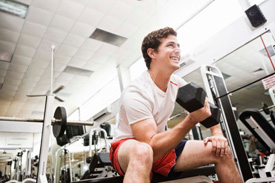
Always use the correct technique as instructed by your trainer
Too often when we’re at the gym, we see people working out on their own who fail to practice the good technique taught by the trainers.
Not only does this undermine the effectiveness of the exercise by not engaging the right muscles, it can cause injury.
As Chiropractors, we are always looking at posture and technique. Doing a movement the correct way is generally more important than how much weight you lift.
While reams have been written about the fine details of technique for various weight-lifting movements, bear in mind that the “textbook” way may not be best for you. Perhaps you have a limited range of motion because of an old injury or chronic condition. Pain is your guide—if it hurts, stop and consider why. What’s most important is that you do the movement in the safest way that gives you the most leverage on the muscle group you mean to target.
For example…
Take, for example, a barbell curl to work the biceps. You should stand tall with chest proud, shoulders down, and elbows back and tight to your sides. The effort to curl the bar up to your chest should come from your arms. Curl the bar to your collarbone with minimal movement by the elbows.
Now, if you can do that 10 times without it being a struggle on the last couple of reps, the weight’s not high enough.
But if you can only do it by swinging and arching your back and engaging your shoulder muscles, you’re probably using too much weight. Is there a risk of injury in this case? Maybe. Are you effectively working your biceps? Likely not. Your biceps will get a better workout if you reduce the weight. Don’t let your ego get in the way of common sense.
Guard your lower back
But sometimes, it’s just difficult to see what your body is doing, or not doing, the same way someone else’s experienced eye can. Don’t rush. Take your time and be conscious of your posture through the movement.
The biggest risk is most often to the back, especially with big compound movements like a squat or a lift. People throw their backs out all the time with mundane tasks like pulling a weed or picking up the morning paper. So consider how important it is to be mindful of technique when lifting big weights.
Always keep your chest proud: This forces your shoulders back and engages the muscles in your core. Those abdominal muscles are called your “core” for a reason—they support everything else. From backsquats, to bench presses, deadlifts, and overhead presses, a tight and contracted core is your best friend. It provides more power to your lift. Most importantly, it stabilizes your whole body and avoids excessive strain on the lower back.
Use your knees and hips as levers: With lifting movements, the key to keeping that chest up and those shoulders back is bending with the knees and hips and planting your weight back on your heels.
Keep your back arched: If you are following the first two tips, this one should take care of yourself, but still, think about it while you are doing it.
Breathe out as you take the load: Expelling air again contracts those core muscles and gives you more power and stability.
Why does it matter?
Two words: Disc Herniation. This is one of the most common and impactful injuries you can suffer in the gym. It happens most often because the spine is allowed to flex and bend forward.
Even if your discs can bear poor technique, you can still pull and tear muscles in your lower back.
Final thoughts
Technique is important, but it’s not the only thing. Proper hydration, nutrition, and rest are all vital to ensure your body can take what you throw at it and you are alert enough to pay attention to your form. And let’s not forget warming up. Cold and stiff muscles often don’t have the flexibility to achieve proper form and are more easily injured.
Take the time to practice the movement first with a lighter weight as a warm-up. This will get the blood flowing and help you get your technique down pat before you tackle the heavier weights called for in your workout.
Did you find this information useful?
I hope you did. Please share it with your friends. You can also follow us on Facebook, Twitter, and YouTube, where we regularly post on other health-related topics. Our website also has great information about Chiropractic care and other health-related topics, such selecting the proper pillow for your sleeping habits.
